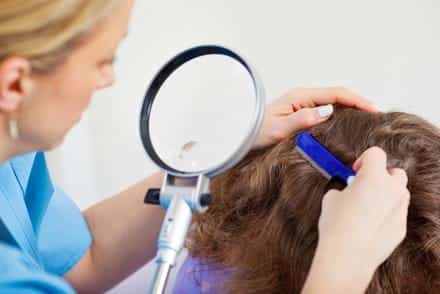What is Pediculosis?
Pediculosis (or the infestation of head lice) is very common in the United States, especially among school-age children. Because head lice are transmitted by direct contact with the head or hair of an infested person, children are common victims due to tight quarters in classrooms and day care centers. Head lice do not fly or jump, they are passed through direct contact only. Girls are at a higher risk of head lice infestation than boys because of social behaviors (for example, the social acceptance of close physical contact and the sharing of hats, combs, and hair accessories).
The adult louse can survive for up to 1-2 days without a blood feeding; consequently, they can be found on objects that have been in contact with an infested person.
Examples of objects that frequently spread head lice are:
- Combs and brushes
- Hats
- Hair accessories/hair clips/ headbands
- Headsets/ear phones
- Helmets
- Clothing
- Coats
- Pillows
- Stuffed animals
Identifying a head lice infestation

The most common sign of a head lice infestation is an itchy scalp. The saliva of the louse is left on the scalp in tiny lesions after a blood meal. This saliva is what causes irritation and can lead to intense itching. If head lice are left untreated, the victim may be at risk for a secondary infection due to the scratching of the scalp with unclean hands. Very severe cases may cause swollen lymph glands.
Other indications of a head lice infestation can be found with close inspection of the scalp. The scalp may contain nits, nit shells, live lice, and/or small dark fragments of the louse feces. Nits are often confused with dandruff, dry scalp or dried hair spray. The difference can be found by attempting to separate the nit from the hair strand. Dandruff, dry scalp and hair spray can be easily removed from the hair, while nits remain securely attached.
Prevention tips
Learning the signs and symptoms of head lice are often the best way to catch an infestation early and treat it. If children are present in the household, keeping in touch with the local schools is often beneficial as lice outbreaks are usually reported to school nurses and administrators. Teaching children to avoid sharing personal items at school is also advantageous. Another helpful tip is to check the heads of family members periodically for lice and eggs. Fine-tooth steel nit combs are great tools for going through hair to check for an infestation.
If an outbreak does occur, treat with a pediculicide making sure to take it slow and follow all directions completely. Carefully remove all nits and dead lice after treatment with a nit comb. Even if all lice and eggs appear to be gone, following through with a second treatment within 7 days and random head checks can prevent future reinfestations. A successful head check includes starting at the nape of the neck and behind the ears and working forward. Use a nit comb to check the hair section by section under a bright light.
